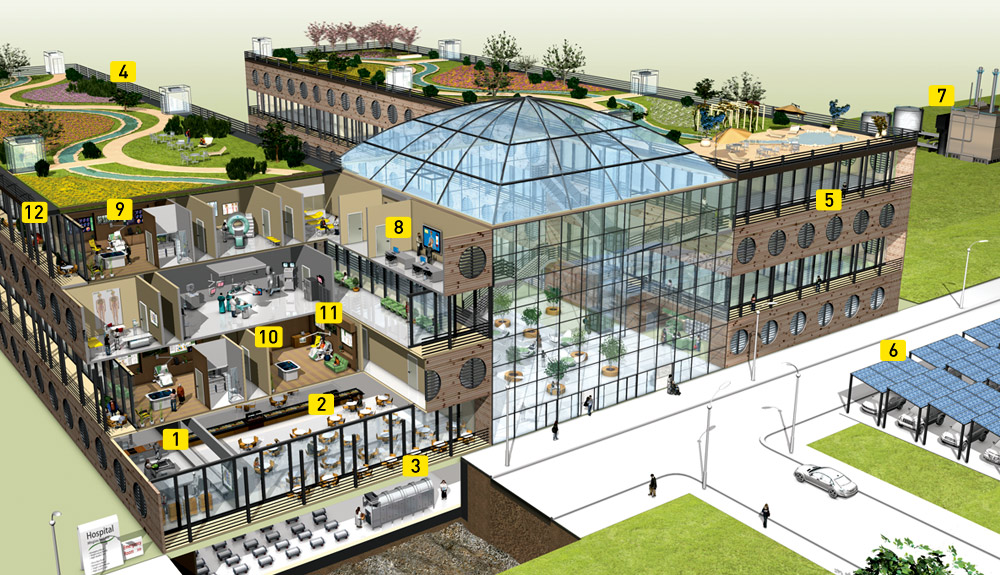
1. THE KITCHEN
New composting machines can reduce waste by breaking food down into air, water, and fertil-izer for gardens. Costs can also be kept in line with Aramark's forthcoming computerized ordering systems, which provide up-to-date information on patients' status and dietary restrictions, so that food is prepared only as needed.
2. THE CAFETERIA
Natural materials and warm lighting -- daylight filters in from the neighboring atrium -- create a less stressful, more inviting environment for hospital staff as well as patients' friends and families. Meals are served in disposable containers made from biodegradable materials such as sugar cane, rather than Styrofoam.
3. THE LAUNDRY
Moving from disposable to reusable gowns cuts waste but creates laundry -- and even a small hospital already has millions of pounds of sheets, towels, and scrubs to wash each year. The solution: industrial 80-foot-long tunnel washers, like those made by Jensen, that use just 1 gallon of water per load -- and then recycle it.
4. THE ROOF GARDEN
Every hospital needs an oasis, but it's not just an aid to patients and visitors. A rooftop garden also helps regulate building temperature, providing an extra layer of insulation while absorbing rainwater to reduce the strain on overtaxed sewers.
5. THE WINDOWS
Operable windows and shading devices allow natural ventilation and reduce the need for air-conditioning.
6. THE PARKING LOT
Solar panels over the parking lot shade cars while harvesting enough energy to supply 50% of the hospital's electricity needs.
7. THE POWER PLANT
An ultra-efficient on-site power plant takes the hospital off-grid, rendering it blackout-proof. Designed by Burns & McDonnell, this natural-gas-burning model can meet all of a hospital's electric, medical-gas, and temperature-control needs while cutting 20,000 tons of earth-harming emissions yearly -- equal to taking 3,600 vehicles off the road.
8. THE TELECONFERENCING CENTER
Doctors can follow up with patients in their homes via Cisco's teleconferencing technology, saving the time, expense, and emissions of a return visit to the hospital.
9. THE HOSPITAL BED
Stryker's "InTouch" bed combines high-tech features, such as a 24-language translation tool, with complete range-of-motion capability -- a patient can lie completely flat or sit fully upright, a degree of control that research shows improves patient morale and promotes movement.
10. THE ELECTRONIC MEDICAL-DATA SYSTEM
Good-bye, clipboards! Infusion Development's Microsoft Surface health-care app allows physicians to access a full range of patient data. Videos and charts illustrating procedures can be used to inform patients and ease anxiety.
11. THE FAMILY AREA
Patient rooms should include adequate space for guests -- a family's sustained presence in the hospital room can help speed recovery. Steelcase's pull-out sofa is made of recycled materials.
12. THE VIEW
Research suggests that patients with views and access to nature require fewer medications, experience less pain, and recover more quickly than patients without.